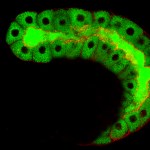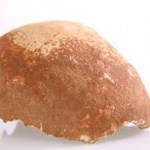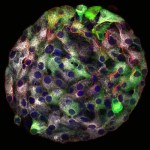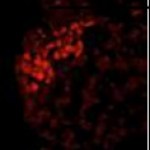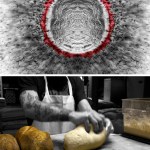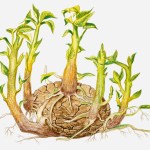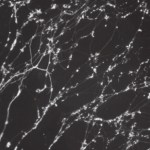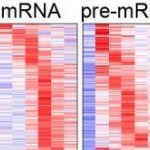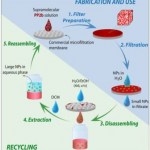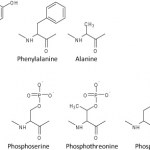biochemistry
Cells that “spit” out their contents and messenger RNA that is not so swift at delivering its message. Those are two brand new stories on our new and improved website. Check it out and let us know what you think.
The first story arose from a simple question: How do secretory cells – those that produce copious amounts of such substances as tears, saliva or all those bodily fluids – manage to get their contents out of the cell? Cells are walled all the way around; they don’t really have doors for letting things the size of a drop of fluid out. Instead, they use the vesicle system – small globes…
Ziv Zwighaft
Ziv Zwighaft is a research student in the group of the Weizmann Institute’s Dr. Gad Asher. Their new findings reveal some intriguing connections between our circadian clocks – which tick according to cycles of day and night – metabolism and aging. Here is his description:
King Solomon said: “There is a time for everything, and a season for every activity under the heavens.”
Our research tries to take this insight into the condition of living creatures a few strides forward. How strictly does it apply? Our lives are regulated by a biological clock – it’s actually many clocks…
“Inclusion bodies – those clumps of protein that are found in the brain cells of Alzheimer’s patients – are, sadly, a product of aging,” says Dr. Maya Schuldiner. “They can form naturally in practically all cells, but when these cells get old, the mechanism for clearing them away starts to fail.”
That is not great news for those of us who are already seeing signs of incipient dementia every time we forget a name or misplace our keys. But of course there is good news too. Schuldiner has discovered a “detergent” that cells make to wash away those nasty protein clumps. And she believes that, in…
Manot Cave cranium
With a skull and Keats, there was little choice but to write about the new online items in rhyme. So with apologies to Shakespeare, Keats and the scientists, as well as the people at SpaceIL, here are today's grab bag of poems. As usual, follow the links.
On a Lone Cranium
Alas poor Yorick – We can only know
Where you lived all those eons ago
Walking, did you take those others in stride;
Human, yet strange, as they strode alongside?
Did your children wander forth,
Searching for a greener North?
Can your skull, a bit of bone,
Tell us where our seeds…
What's in a picture?
Prof. Benny Shilo knows the value of a good picture. We recently mentioned his book: Life’s Blueprint, which uses photographs of things like bread dough and yeast cells to illustrate the process of biological development. Here is the image from the most recent piece we have uploaded on his research:
This is an individual Islet of Langerhans, as you’ve never seen it before. The white dots are the insulin-containing vesicles inside the beta cells, which both sense glucose levels and secrete insulin. Shilo and his team managed to get “close-up shots” of the individual cell…
Getting cells to revert to a stem-like state – creating so-called induced pluripotent stem (iPS) cells – was a true revolution, but the technique invented in 2006 is only half the game. The first challenges include getting enough adult cells to undergo the “reprogramming” in culture to be of use and removing those traces of “priming” that distinguish them from true embryonic stem cells. The second is keeping them in the iPS state – that is, holding back their urge to differentiate – in lab conditions. And then there is the challenge of directing their differentiation in the way that you want…
On Pharyngula, PZ Myers criticizes the stubborn obfuscations of Michael Behe, who refuses to yield his illogical calculations. Behe says (rightly) that a certain mutation necessary for drug resistance in the malaria parasite has about a 1 in 1020 chance of occurring. But the mutation is also detected in 96% of malaria patients who respond well to the drug; it proliferated widely because, by itself, it had no impact on the parasite's fitness. The parasite needed another mutation, occurring at a later date, to develop resistance to the drug. Behe rests his case for divine intervention on the…
A new book will make you stop and think about the relationship between the microscopic world and the one we pass by every day.
Life’s Blueprint – The Science and Art of Embryo Creation; Benny Shilo, Yale University Press, 174 pages.
Stem cells and their niche
When a stem cell divides, one daughter maintains the stem cell fate while the other produces a differentiated progeny. Stem cells are positioned in a restricted spatial niche that provides signals maintaining them in a proliferative, nondifferentiated state. After division, only the undifferentiated progeny is retained in the niche.…
The next time you reach into the fridge for a midnight snack – take heed: New research by Weizmann Institute scientists has shown that the time at which you eat your meals might have a profound effect on your liver triglyceride levels. Their research was conducted on mice, but if found to be true for humans as well, it may have clinical implications in the way patients could be treated for fatty liver and other metabolic diseases, which are characterized by abnormally elevated levels of lipids in blood and liver cells.
Our bodies are naturally cued to carry out various biological…
X-STEM - presented by Northrop Grumman Foundation and MedImmune - is an Extreme STEM symposium for elementary through high school students featuring interactive presentations by an exclusive group of visionaries who aim to empower and inspire kids about careers in science, technology, engineering and mathematics (STEM). These top STEM role models and industry leaders are sure to ignite your students’ curiosity through storytelling and live demonstrations.
Our spotlight on our X-STEM Speakers continues with Biochemist Dr. Robert Tjian from Howard Hughes…
Since the haiku post was well received, and since we have another three pieces online today – each on a different finding and each interesting in its own right – I have decided to return to the haiku format. Among other things, there is something quite satisfying about distilling complex scientific findings down to 17 little syllables – like writing the perfect tweet, but more so.
In any case, follow the links to read more:
A burst of enzymes:
A transcription traffic jam
Watch for gene speed bumps
Genetics can rid
The poison from potatoes
Or add it elsewhere
image: Thinkstock…
To attain knowledge, add things every day. To attain wisdom, remove things every day.
Lao Tsu
Apparently our nervous systems develop according to the Chinese philosopher’s principle of being and not being. As our nerve cells grow, they send out long extensions – axons – throughout the developing tissues. And as they reach out, some are also pruned back. The configuration of nerve endings we finally possess depends on both what was added and what was removed.
Which axons will complete their developmental journeys and which will be pruned back? For some, it is simply a matter of fate.
But in…
“The public, blog-fueled controversy over the utilization of arsenate instead of phosphate in bacteria was, in the end, a demonstration of what is truly right with scientific quests,” says Prof. Dan Tawfik. “The original findings (that certain bacteria can use arsenate instead of phosphate) may have been overhyped. The research itself may have been underwhelming. But what ensued is exactly what should have happened: The correcting mechanisms that are intrinsic to science kicked in. Other experimental groups examined the claims in their labs and found them to be unsupported. And new scientific…
Blurring, chopping and blocking. Three online items this week all deal with some pretty dynamic phenomena.
The blurring is in our perceptions. It turns out that if you even think you have lost money in an experiment, your ability to distinguish between musical notes will be hampered. What’s the connection? Dr. Rony Paz has been showing that this tendency to lump sounds together is tied to fear. In our evolutionary past, humans may have survived because anything that sounded remotely like a predator aroused an immediate “fight or flight” response. But if mild stress can provoke a similar…
A somewhat accidental discovery and random meetings between proteins in a cell: These are the subjects of two new online articles. Each, it its way, involves a technological advance that will, in turn, lead to further scientific discovery.
The first involves a partnership between a physics group and a cancer-research group. Among other things, such collaboration is essential for dealing with large data sets - multiple gene expression patterns, for example. When the team made their discovery, they were looking not just at gene expression, but at pieces of genes. More precisely, they were…
Often, simply identifying the structure of a potential drug target protein and designing a molecule to block it are not enough. Just ask Prof. Irit Sagi, a chemist turned biology researcher, who recently developed a clever technique for directing the body to design its own protein-blocking molecules.
Sagi studies an enzyme called matrix metalloproteinase 9 (MMP-9). This protein, along with other members of the MMP family, cleaves straight through the support tissues in the body - collagen and the extracellular matrix that gives organs and tissues structure. This, of course is crucial for…
Two completely unrelated papers have got us thinking about chemical bonds. When we refer to chemical bonds, we generally mean covalent bonds: Atoms become "wedded," sharing electrons, and breaking them apart takes energy. By comparison, other types of bonds are weak attractions - mere flirtations, or mild sparks between hydrogen and oxygen in passing water molecules.
So why would a researcher in organic chemistry - a field based on carbon, the king of covalent bonds - be investigating the properties of non-covalent, hydrophobic bonds? The answer, of course, is that they can be used to create…
Last year, I wrote about a scientific controversy over the structure of the influenza M2 proton channel, particularly over the protein's binding site for adamantane type anti-flu drugs. The Schnell/Chou model, based on solution NMR, had the drug binding to the outside of the channel, within the membrane (at a 4:1 drug:protein ratio). On the other hand, the Stouffer/DeGrado model had the drug binding inside the channel (1:1 ratio), based on X-ray crystallography studies.
A new study was recently published in Nature (the same journal that published the original two competing papers), based this…
tags: evolutionary biology, behavioral ecology, biochemistry, biophysics, magnetoreception, photoreceptor, cryptochromes, geomagnetic fields, butterflies, Monarch Butterfly, Danaus plexippus, birds, migration, signal transduction, researchblogging.org,peer-reviewed research, peer-reviewed paper
Every autumn, millions of monarch butterflies, Danaus plexippus, each weighing less than one gram (one US penny weighs 2.5 grams), migrate nearly 4000 kilometers (3000 miles) between their summer breeding grounds in the United States and their wintering areas either in southern California or in the…
When doing science, there's generally one totally optimal way of performing an experiment. But, there may also be several other less optimal means of gathering similar data, and one of those may be much more feasible than the totally optimal method. As a scientist, you have to determine whether this other method is sufficient, or whether it's necessary to expend the extra effort and/or resources on the more difficult method. Sometimes it's totally fine to take the simpler approach (and this will spare some of your precious time and your lab's precious funding), but this post is about a case…
